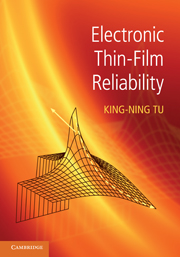Book contents
- Frontmatter
- Dedication
- Contents
- Preface
- 1 Thin-film applications to microelectronic technology
- 2 Thin-film deposition
- 3 Surface energies
- 4 Atomic diffusion in solids
- 5 Applications of the diffusion equation
- 6 Elastic stress and strain in thin films
- 7 Surface kinetic processes on thin films
- 8 Interdiffusion and reaction in thin films
- 9 Grain-boundary diffusion
- 10 Irreversible processes in interconnect and packaging technology
- 11 Electromigration in metals
- 12 Electromigration-induced failure in Al and Cu interconnects
- 13 Thermomigration
- 14 Stress migration in thin films
- 15 Reliability science and analysis
- Appendix A A brief review of thermodynamic functions
- Appendix B Defect concentration in solids
- Appendix C Derivation of Huntington's electron wind force
- Appendix D Elastic constants tables and conversions
- Appendix E Terrace size distribution in Si MBE
- Appendix F Interdiffusion coefficient
- Appendix G Tables of physical properties
- Index
- References
14 - Stress migration in thin films
Published online by Cambridge University Press: 05 July 2014
- Frontmatter
- Dedication
- Contents
- Preface
- 1 Thin-film applications to microelectronic technology
- 2 Thin-film deposition
- 3 Surface energies
- 4 Atomic diffusion in solids
- 5 Applications of the diffusion equation
- 6 Elastic stress and strain in thin films
- 7 Surface kinetic processes on thin films
- 8 Interdiffusion and reaction in thin films
- 9 Grain-boundary diffusion
- 10 Irreversible processes in interconnect and packaging technology
- 11 Electromigration in metals
- 12 Electromigration-induced failure in Al and Cu interconnects
- 13 Thermomigration
- 14 Stress migration in thin films
- 15 Reliability science and analysis
- Appendix A A brief review of thermodynamic functions
- Appendix B Defect concentration in solids
- Appendix C Derivation of Huntington's electron wind force
- Appendix D Elastic constants tables and conversions
- Appendix E Terrace size distribution in Si MBE
- Appendix F Interdiffusion coefficient
- Appendix G Tables of physical properties
- Index
- References
Summary
Introduction
Stress-induced atomic migration is creep as we have discussed in Chapter 10. We have emphasized that it is stress gradient not stress that can induce atomic diffusion. From the viewpoint of device reliability, we must ask the following questions. First, from where is the stress coming? Second, how does a stress gradient develop in an interconnect? Third, how can the elastic stress gradient induce atomic migration? Fourth, what is the mechanism of creep that leads to void or whisker formation to cause failure in interconnects? Finally what is the rate of creep [1–4]?
On the first question, typically the answer is thermal stress which occurs due to different thermal expansion coefficients in the interconnect structure. The most obvious one is that between Al (or Cu) metallic wire and the interlayer dielectric insulator. Another one comes from the chip-packaging interaction in flip-chip technology because of the large difference in thermal expansion between the chip and the packaging substrate. Then, electromigration can introduce back-stress in interconnects as discussed in Chapter 11, Section 11.6. Mechanical stress due to externally applied force is rare in electronic devices. However, we should mention impact-induced stress due to the dropping of a handheld device to the ground. The impact is a high rate shear in a very short time, about 1 millisecond, or a shear rate of 1 × 103 cm/s. Since impact failure is not a long-time event as in creep, we will not cover it here.
- Type
- Chapter
- Information
- Electronic Thin-Film Reliability , pp. 309 - 335Publisher: Cambridge University PressPrint publication year: 2010



